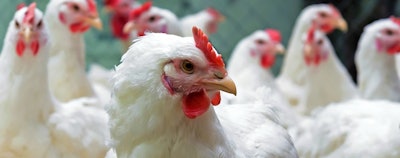
Significant advancements have been made in poultry production over the last 50, 10, and even 3 years. Although improvement in genetics have helped producers increase performance efficiency (e.g. FCR, weight gain per day), other factors play a significant role as well.
"Achieving and maintaining good animal welfare in today’s production environment comes down to minimizing an animal’s susceptibility to stressors in the environment."
Promotion of good management and natural behavior, disease prevention and treatment, and minimizing stress are all factors which are equally important to maximize the genetic potential of birds. These factors can be assigned to one of the established Five Freedoms: freedom from hunger and thirst, freedom from discomfort, freedom from pain, injury or disease, freedom to express normal behavior, and freedom from fear and distress (Brambell, R., 1965; Farm Animal Welfare Council, 1992).
Historically, animal welfare was measured based on mortality, stocking density and other disease markers (Manning et al., 2007). Today, these Five Freedoms are the basis of how producers are assessing animal welfare and ensuring that the physiological, physical, and behavioral needs of the birds are being met (Sejian et al., 2010). In this way, animal welfare is truly being assessed in real-time during the growing period to optimize animal health and performance – starting with the guidelines of nutrition and feeding (quality and consumption), shelter (temperature, ventilation), health monitoring, and husbandry.
Achieving and maintaining good animal welfare in today’s production environment comes down to minimizing an animal’s susceptibility to stressors in the environment. These stressors can include disease, mycotoxin exposure, environmental factors, such as heat, and more. For birds to thrive in their environment and achieve optimal performance, they must also maintain efficient nutrient digestion and absorption, optimal metabolic processes, a stable and diverse microbiome, an effective intestinal barrier function, and a healthy immune response – all of which enable the bird to withstand infectious and non-infectious stressors (Kogut and Arsenault, 2016). Many of these complex, biological processes happen at the cellular level of the intestine.
Any negative impact on gut health through disease or non-disease challenges can therefore negatively impact performance, and ultimately welfare. In addition to decreased performance, constant or repetitive intestinal challenges like E. coli or Clostridia can hinder the bird from exhibiting natural behaviors (e.g. dust bathing), cause distress (e.g. lethargic), or result in injury (e.g. leg issues). Certainly, there is a balance that must be attained in meeting a bird’s welfare needs, such that outside environment access promotes bone strength (Van de Weerd, 2009) and natural behaviors (Skomorucha et al.), yet the risk for disease exposure is minimized.
To minimize an animal’s susceptibility to intestinal diseases, positive interactions must exist between the key “factors” of gut health: microbiota, intestinal immune system, and epithelial barrier. The need to maintain and improve animal welfare through the achievement of proper gut health has led to the development of a wide array of feed additives. There are numerous feed and water additives that can be used to promote and maintain gut health, ranging from organic acids, prebiotics, and probiotics to phytochemicals, enzymes, and trace minerals.
To truly provide value to animal production systems from a performance standpoint, these additives must impact either the microbiota, intestinal immunity, or epithelial barrier both at a cellular and physiological level. A single feed additive may not be sufficient to maintain performance in all production situations, a combination of various additives that impact specific production challenges has the potential to offer gut health solutions, thereby improving welfare.
For more information about the Kemin Gut Health Triple Check program, visit kemin.com/guthealth.
References
Dr. Vanessa Iseri, Kemin Industries. 2019. Animal Welfare: A Gut Health Perspective.
Brambell, R. 1965. Report of the technical committee to enquire into the welfare of animals kept under intensive livestock husbandry systems. Her Majesty’s Stationery Office, London, UK.
Farm Animal Welfare Council. 1992. FAWC updates the five freedoms. Vet. Rec. 17:357.
Kogut, M. H., and R. J. Arsenault. 2016. Editorial: Gut Health: The New Paradigm in Food Animal Production. Front Vet Sci 3:71. doi: 10.3389/fvets.2016.00071
Manning, L., S. A. Chadd, and R. N. Baines. 2007. Key health and welfare indicators for broiler production. World’s Poultry Science Journal Vol. 63:46-62.
Sejian, V., J. Lakritz, T. Ezeji, and R. Lal. 2010. Assessment methods and indicators of animal welfare. Asian J. Anim. Vet. Adv. 6:301–315.
Skomorucha, I., E. Sosnówka-Czajka, E. E. Herbut, and R. Muchacka. 2007. Effect of management system on the productivity and welfare of broiler chickens from different commercial lines. Ann. Anim. Sci. 7:141–151.
Van de Weerd, H. A., R. Keatinge, and S. Roderick. 2009. A review of key health-related welfare issues in organic poultry production. World’s Poult. Sci. J. 65:649–684.

















